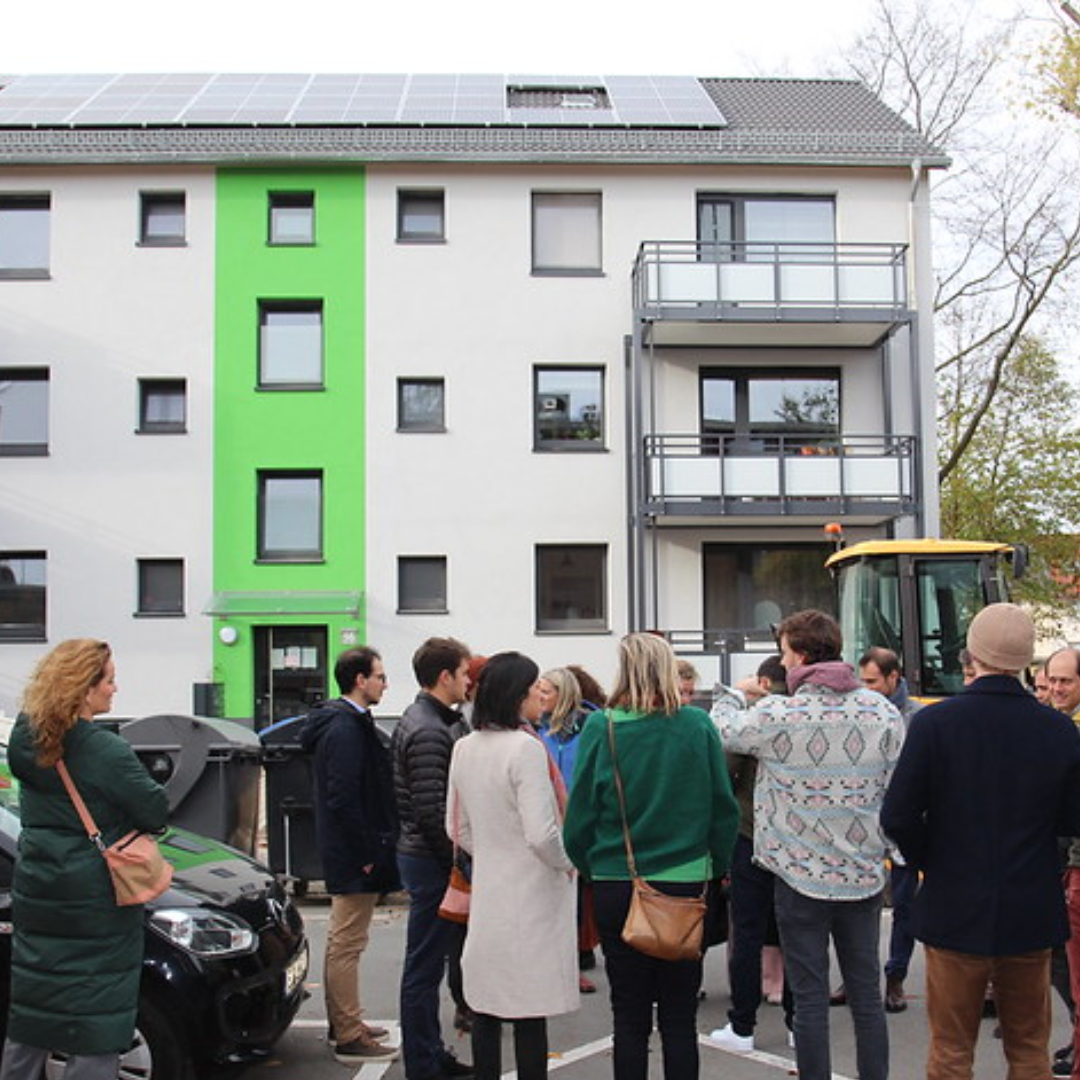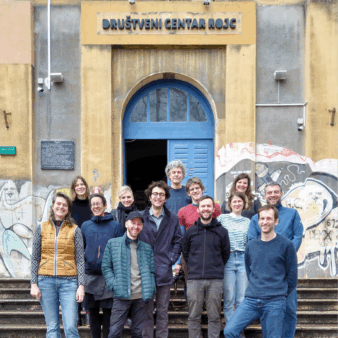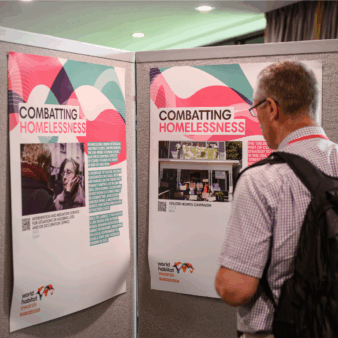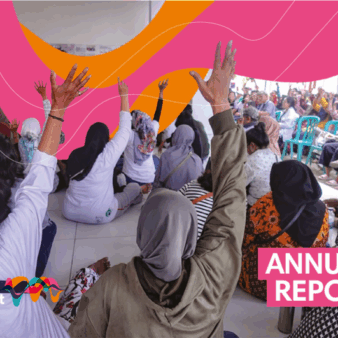
In this interview, David Ireland, CEO of World Habitat, joins members of the 2024 Gold World habitat Award Winners, Energiesprong Global Alliance. Sanne de Wit, Sebastien France and Thomas Miorin talk about the initiative’s mission to tackle fuel poverty and climate change, and its remarkable international expansion. Read on to discover how this open-source movement is driving transformation and collaboration in the social housing sector, and creating a just transition towards a net-zero future.
David: Can you tell us about Energiesprong, its mission and what problem it aims to solve?
Sanne: Energiesprong started in the Netherlands to address the challenge of renovating social housing to be more energy efficient. The government was no longer providing sufficient financial support, and housing organisations had no money to do anything with their housing stock. So, we created a finance model for housing organisations to generate revenue for renovations, in turn benefiting people on low incomes who are the most affected by high energy bills.
In the Netherlands’ Energiesprong system, tenants pay a set “energy fee” to the housing organisation, equal to a traditional energy bill. The housing organisation then uses that income stream to fund deep energy retrofits, ultimately leading to net-zero energy homes and eliminating energy bills for tenants. Once the model was established, we started working with construction companies to find the cheapest and fastest net zero retrofit packages.
David: So, it tackles both fuel poverty and helps the climate emergency?
Sanne: Absolutely. Tenants wouldn’t pay more than they were already paying for energy, ensuring affordability and shielding against energy hikes, while also contributing to a significant reduction in carbon emissions.
David: Energiesprong has expanded beyond the Netherlands. Can you tell us about its international growth?
Sanne: We started as an innovation project in the Netherlands over 15 years ago. Interest grew organically from other countries like France, the UK, Italy, and Germany, leading to teams adapting the Energiesprong approach to their respective contexts. We even had teams in New York and California at one point. Each country has unique needs and challenges, so this decentralized approach allows for flexibility of the idea and implementation.
Sebastien: That’s right, and the Energiesprong teams have all come from different stakeholders. In Italy, for example, the team came from an SME, in Germany it was the national energy organisation and in the UK it was a non-profit. And myself in France, as a sustainability consultant.
David: And what interested you Sebastien in the Energiesprong model for the French market?
Sebastien: As a sustainability consultant I was seeing that housing organisations would only implement about 20% of their decarbonisation roadmap, because they wouldn’t question their business model or value chains. There was no innovation, at least not the kind you see in the motor and other sectors.
So on a fundamental level, our role is about changing mindsets, leading people to step back from ‘business as usual’ and showing that things can be done differently. Energiesprong country teams are facilitators, connecting stakeholders across the value chain – housing organisations, construction companies, policymakers, and more. Our independence and the open-source aspect of Energiesprong are crucial to drive innovation, build trust and ensure all parties can work together effectively.
David: Would you say Energiesprong is a disruptor in the housing market?
Sebastien: Perhaps, but some disruptors create problems without considering the consequences. We, on the other hand, are deeply committed to positive social and environmental impact.
David: Looking out at the city from the office I’m working from today, it’s clear that most buildings are far from net-zero. What’s your perspective on the scale of this challenge?
Thomas: It’s huge. Across Europe, we need to retrofit 20,000 homes every day to reach net-zero by 2050. In Italy alone, that’s one home every minute! We need to triple our current retrofitting speed and significantly deepen the level of energy efficiency achieved in each project if we are to meet the 2050 target.
David: One home a minute is a staggering statistic. What’s the current pace of retrofitting?
Thomas: We’re currently retrofitting at about one-third of the necessary speed. And crucially, most of these retrofits aren’t deep enough to achieve the required level of decarbonization.
David: So, one home every three minutes, but not to the necessary standard. Are there any countries that are leading the way in encouraging more effective retrofits?
Sanne: Everyone is moving too slowly. In the Netherlands, we were making good progress with large-scale deals between housing organisations and construction companies. This long-term vision allowed construction companies to plan for scaling up, in terms of resources which helped them to innovate and keep costs down. However, changes in government leading to policy changes disrupted this momentum, forcing a shift from portfolio-wide retrofits to a neighbourhood-focused approach. This is when a lot of planned work stopped.
David: It sounds like policy stability is crucial. Housing is a long-term business after all.
Sanne: Absolutely. Long-term policy frameworks are essential for sustained progress.
The other issue is the funding gap. Germany is a good example where government subsidies are helping to bridge this gap, accelerate innovation and commit to some longer-term plans. Energiesprong is really progressing there.
David: What are your thoughts on the European Commission’s recent announcement of an affordable housing plan and potential changes to state aid rules?
Thomas: It’s a crucial step. The key is ensuring a just transition. We need to stimulate a huge market and have a European scale response. Within that European market, each country brings unique strengths to the table. France is pioneering regional portfolio management, Germany is integrating industrial construction policy with housing retrofit subsidies, Italy focuses on seismic retrofitting and cooling, and the Netherlands leads in bio-based materials and community.
The fact that Energiesprong is an open innovation movement allows for cooperation and exchange in the supply chain, between demand and offer, finance and market regulators, but also, as I was saying, between regions and countries. You could say that Energiesprong is an international learning community committed to a just transition to net-zero housing, and especially social housing. So, to have a European plan that supports that is really, really important.
David: Is there anything more the EU could be doing?
Thomas: Social housing providers operate with tight budgets. They are struggling to even maintain existing buildings. Like in Milan, there are 28,000 social homes, but they can only rent 22,000 because they can’t afford to renovate the other 6,000. To align social and environmental goals, we need deeper innovation to lower maintenance costs, increase social housing stock, and achieve decarbonization targets. This requires new incentives and financial mechanisms.
David: The Grenfell Tower tragedy raised concerns about retrofitting safety. How does the Energiesprong system address fire safety?
Thomas: There was a similar tragedy here in Italy, in fact, but certainly Grenfell was a turning point for fire safety regulations across Europe, and I think that has answered a lot of people’s fears. There is also a shortage of labour in Europe, which can lead to an unskilled workforce. By contrast, Energiesprong solution providers commit to a 30-year warranty, ensuring accountability for the long term. Also, because we manufacture off-site we have greater quality control, and we can better train a workforce in repeatable and specific processes. This minimises risks and improves safety.
David: Beyond energy savings, what are the wider social benefits of the Energiesprong system?
Sanne: Ultimately, it’s about people. Energiesprong retrofits transform not just buildings, but entire communities. They improve health, well-being, and self-esteem. We’re not just retrofitting homes and generating financial savings; we’re investing in people. We’ve seen positive impacts on entire neighbourhoods. In the Netherlands, where 70% tenant approval is required for retrofits, we engage deeply with residents, addressing their concerns and incorporating improvements beyond energy efficiency, like increased storage space, creating parks or meeting places, offering discounts for other home improvements. But also, we were told by residents that they didn’t feel as stigmatised for living in social housing. This all helps community cohesion and creates a sense of pride.
Sebastien: We’ve also observed unforeseen benefits like increased home security, as the retrofits make burglaries and break-ins harder. Also, off-site construction has increased inclusion in the workforce. This is because factories tend to employ more women for example than construction sites, and prefabrication allows for a wider range of skills and abilities, including older workers and people with disabilities.
David: Can the Energiesprong model be applied to private housing as well
Sebastien: Absolutely, it could be, but we see it as a domino effect. Social housing acts as the first domino, driving innovation and creating economies of scale. This makes it easier for the second domino to fall – the offer for private housing. We are exploring collective buying schemes for individual homeowners to achieve the necessary scale for prefabrication. But it will need much more social and financial innovation for this kind of community-led buy-in to happen and we’re not quite there yet.
David: Thank you, that is certainly food for thought. Finally, do you have a call to action?
Sebastien: We need a shift in perspective within the financial community and regulatory bodies. Net zero energy retrofits require significant upfront investment, which deeply challenges the traditional debt-to-income ratio we are all comfortable with. In order to achieve our 2050 carbon commitments we need to recognise the long-term value of these investments, and their climate impact, and adapt financial regulations accordingly.
David: Thank you all for this insightful conversation. It’s been truly inspiring to learn about the transformative potential of the Energiesprong approach.




Join the discussion